AUGUSTE RODIN
- his life, his work (8)
|
|
|
|
|
1908
|
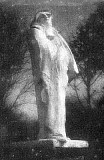 King Edward VII of England visits Rodin in Meudon. King Edward VII of England visits Rodin in Meudon.
The Metropolitan Museum of Arts purchases 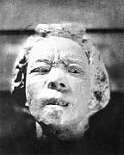 several works of Rodin.
several works of Rodin.
Edward Steichen takes photos of the 'Balzac' in the moonlight in
Meudon.
Rodin now lives inside the terrain of the Hôtel Biron in Paris, like already
Rilke, the dancer Isadora Duncan, Jean Cocteau and Henri Matisse did.
Portraits of the Japanese dancer 'Hanako', the Duchesse de Choiseul and
others.
|
|
1909
|
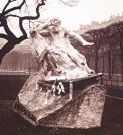 The revised version of 'Victor Hugo', sitting, in
marble, is set up in the garden of the Palais Royal. The revised version of 'Victor Hugo', sitting, in
marble, is set up in the garden of the Palais Royal.
Paul Claudel returns from China and finds Camille in a state of neglection,
destroying her own work piece by piece.
Exhibitions in Prague, Ghent, London.
Completion of the bust 'Gustav Mahler' and 'Napoleon', among others.
|
|
1910
|
Rodin becomes Knight Commander of the Legion of Honour.
The sculptor fancies to isolate fragments from his former work and present
them as art works for themselves. To Muriel Ciolkowska, he explains:
"Recently I have taken to isolating limbs, the torso. Why am I
blamed for it? Why is it allowed the head and not portions of the body?
Every part of the human figure is expressive."
Studies on dance movements with the model Moreno.
Exhibitions in Buenos Aires, Leipzig and New York.
|
|
1911
|
First public exhibition of Cubism
at the Salon des Indépendants.
|
|
1911
|
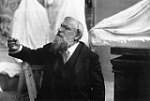 The state acquires the Hôtel Biron for the Ministry of
Public Instruction and Fine Arts; The state acquires the Hôtel Biron for the Ministry of
Public Instruction and Fine Arts; 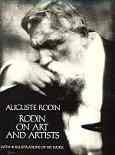 Independent of each other, Judith Cladel and Gustave Coquiot propose to institute
a museum for Rodin's work in the Hôtel Biron; the government orders a commission to examine this suggestion which
is finally realized in 1919. Independent of each other, Judith Cladel and Gustave Coquiot propose to institute
a museum for Rodin's work in the Hôtel Biron; the government orders a commission to examine this suggestion which
is finally realized in 1919.
Short stay in London to visit the site for the 'Burghers of Calais'.
A collection of conversations with the artist edited by Paul Gsell is
published under the title 'L'Art, entretiens réunis par Paul Gsell'.
Exhibititons in Prague, Buffalo, Düsseldorf, Venice, Rome and Berlin.
|
|
1912
|
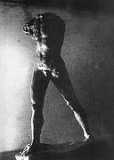 In January, Rodin travels to Italy together with the
Duchesse de Choiseul and inspects the future site of his 'Walking Man'. The cast was donated by admirers to be
placed at the Palazzo Farnese in Rome. In January, Rodin travels to Italy together with the
Duchesse de Choiseul and inspects the future site of his 'Walking Man'. The cast was donated by admirers to be
placed at the Palazzo Farnese in Rome.
Warned by Marcelle Tirel, Rodin breaks his relationship with the Duchesse, before she
manages to be appointed as his heiress; with support of Judith Cladel, other
money-oriented women can be kept away from Rodin who is now weak and
harmed.
First hemiplegia-attack (paralysis of one side of the body).
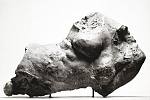 Rodin creates a series of drawings and a statue of the dancer 'Nijinsky',
after Nijinsky's performance of Debussy's "Afternoon of a Faun"
on 29 May 1912 - which raised another scandal in the press.
Rodin creates a series of drawings and a statue of the dancer 'Nijinsky',
after Nijinsky's performance of Debussy's "Afternoon of a Faun"
on 29 May 1912 - which raised another scandal in the press.
Rodin presents a fragmentary plaster torso to the Metropolitan Museum in
New York.
Exhibitions in Venice, Lyon, Tokyo, Rome and Chicago.
|
|
1913
|
Camille has destroyed a great part of her plaster
models, her house is a mess. In March 1913, one week after the death of her father, Camille is
delivered to the mental hospital Ville-Evrard by force. Till her death in 1943, she
will stay in custody, deprived of her art, fearing to be poisoned by the
"Rodin gang". Rodin sends
money to cover the costs for the care.
Exhibitions in Munich, Algier, Ghent, Rome and at the Armory Show
in New York.
|
|
1914
|
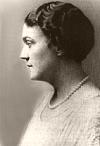 Rodin's studies about 'Les cathédrales de France' are
published. Rodin's studies about 'Les cathédrales de France' are
published.
Mrs Spreckel makes first purchases for her collection which is placed
today at the Palace of the Legion of Honour in San Francisco.
Second journey to England in this year with Rose and Judith Cladel to
evade the outbreak of the war between Germany and
France.
He donates 18 sculptures to the Victoria and Albert Museum.
After a short stay in Paris, Rodin travels to Italy together with Rose and
the American dancer Loïe
Fuller.
|
|
1915
|
Rodin has four sessions for a portrait with Pope Benedict XV in
Rome, but "the German Pope" refuses to let Rodin look at him
from all directions.
Short stay in Florence.
|
|
1916
|
Dada anti-art movement is
flourishing in Zürich.
|
|
1916
|
Second hemiplegia-attack, later an apoplexy. 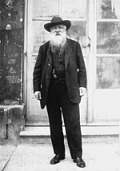 The
French government speeds up the donation of Rodin´s work to the state, in
order to establish the planned Rodin Museum at the Hôtel Biron.
Rodin offers to create a bust of Etienne Clémentel, the Minister of
Commerce, who has overcome the opposition of the anti-Rodinists. At the
fourth state of the portrait, Rodin suffers another stroke, from which he
does not recover completely. He now often sinks in a state of mental
lethargy. In this condition, he signs a deed of gift on 13 September,
according to Grunfeld, transferring his whole work, art
collection and financial assets to the French state, thereby overruling
prior wills in favour of Jeanne Bardey and Loïe Fuller; only his will in
favour of Rose remains in power. The Musée Rodin also mentions two other
donation treaties dated 1 April and 25 Oct. 1916. The transfer is accepted
by the National Assembly on 24 Dec. 1916. The
French government speeds up the donation of Rodin´s work to the state, in
order to establish the planned Rodin Museum at the Hôtel Biron.
Rodin offers to create a bust of Etienne Clémentel, the Minister of
Commerce, who has overcome the opposition of the anti-Rodinists. At the
fourth state of the portrait, Rodin suffers another stroke, from which he
does not recover completely. He now often sinks in a state of mental
lethargy. In this condition, he signs a deed of gift on 13 September,
according to Grunfeld, transferring his whole work, art
collection and financial assets to the French state, thereby overruling
prior wills in favour of Jeanne Bardey and Loïe Fuller; only his will in
favour of Rose remains in power. The Musée Rodin also mentions two other
donation treaties dated 1 April and 25 Oct. 1916. The transfer is accepted
by the National Assembly on 24 Dec. 1916.
|
|
1917
|
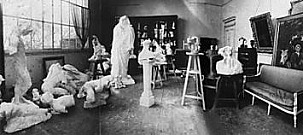
|
Due to the war, fuel is scarce and the French state officials, who
have just cashed in the complete fruits of Rodin's life, leave the old
couple in the unheated house in Meudon. Hinted by Judith Cladel, Rodin
marries Rose Beuret on 29 January.
|
The day before the wedding, the water pipes freeze and burst,
so that the drawing room is flooded. Because of the cold, Rodin and Rose
spend their honeymoon mostly in bed, sharing memories of their life
together. Two weeks later, on 14 Febr. 1917, Rose dies.
Lorries arrive in Meudon to bring all valuable objects to the Hôtel
Biron. Even the gothic crucifix from Rodin's bedroom is carried off,
setting Rodin in rage, till Judith Cladel rescues the situation and orders
the cross to be restored in its old place. Rodin is allowed a visit to the Hôtel Biron only every
second Sunday. On 25 April, Leonce Bénédite presents another will to
Rodin, which should confirm him as the future conservator of the Musée
Rodin. Since then, pens and pencils are kept away from Rodin, to prevent he might
write yet another will. 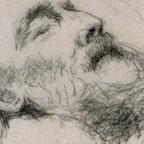 Ruth Butler mentions an additional codicil
set up by Bénédite and signed by Rodin on 15 November, to secure Rodin's
personal souvenirs, portraits and decorations for the Museum. Ruth Butler mentions an additional codicil
set up by Bénédite and signed by Rodin on 15 November, to secure Rodin's
personal souvenirs, portraits and decorations for the Museum.
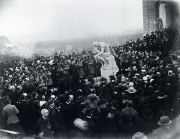 Rodin's son
will merely become his father's watch. Rodin's son
will merely become his father's watch.
On 17 November, Auguste Rodin dies in Meudon. A plaster cast made of
Rodin's hand is combined with a small female torso and given the title
'Hand of Rodin'.
Together with his wife Rose, Rodin is buried in the garden of the Villa des
Brillants in Meudon, on 24 November. A monumental cast of his 'Thinker' is placed
close to their tomb.
|


|